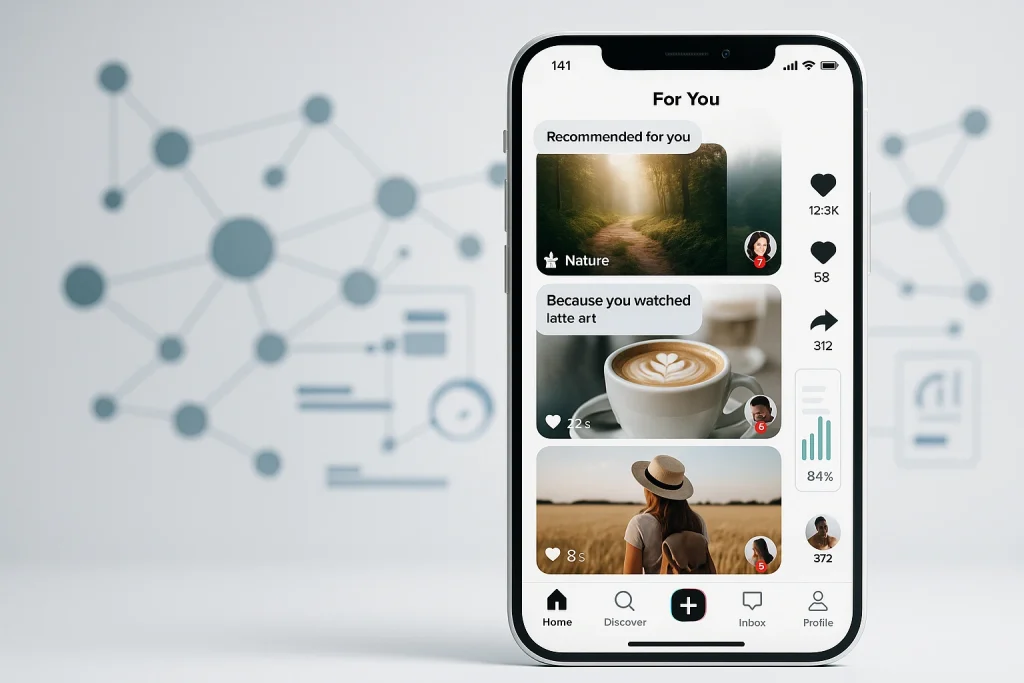Bold claim to start: if your plan still worships likes, you are measuring applause, not behavior. Real growth comes from reading the signals that require effort: saves, rewatches, comments, search‑driven discovery, and the weird little gestures people make when something is good enough to stop their scroll. This piece is your map to those signals. We will turn social media metrics into decisions your CFO respects and your creative team loves building on.
Working premise: numbers are not trophies. They are instructions.
Signal vs. Noise: A quick calibration
A like is easy. A save costs attention. A rewatch costs time. A comment costs energy. A click often signals intent. Treat your metrics like a ladder of effort. The higher the effort, the stronger the intent.
Here is the simple filter we will use throughout:
- See: reach, impressions, views. Helpful for top‑of‑funnel health. Weak on intent.
- Stay: completion rates, average watch time, retention curves, story taps. Strong on attention quality.
- Care: saves, comments, shares, mentions, sentiment. Strong on relevance and emotional pull.
- Change: clicks, profile visits, DMs, form fills. Closest to commercial outcomes.
Your goal is to move posts up the ladder from See to Change using creative choices informed by data, not by folklore.
The Platform Playbook: 19 signals that matter and what to do with each
We will group the most useful social media metrics by platform or behavior family, then translate each into a concrete action. Nothing theoretical. Everything shippable.
Instagram: Intent you can feel
1) Saves — the bookmark of intent
What it tells you: the content was valuable enough to keep.
Action: track Save‑to‑Like Ratio for every post. If a theme repeatedly earns a high ratio, make it a content pillar and build a carousel or guide series around it. Add follow‑ups that go one step deeper than the original.
2) Story Taps — the quiet narrative review
What it tells you: forward taps mean the pace works; back taps signal intrigue; exits signal boredom or confusion.
Action: storyboard Stories with deliberate beats. Put one curiosity anchor in frame 1–2, one payoff in frame 3–4, and a soft next step in frame 5–6. Audit exits per frame to find the fatigue points and trim.
3) Peak Activity Times — when your people actually show up
What it tells you: the windows where early engagement velocity is most likely.
Action: build a Prime Time Matrix by day of week and hour. Schedule two test windows per day for a month and keep the top two performers. Pair timing with creative that has strong first‑frame hooks.
TikTok: the attention laboratory
4) Average Watch Time — quality of the hook
What it tells you: whether your first seconds bought the right to tell a story.
Action: cut intros. Start with the payoff image or sound, then explain. Track the first 3 seconds versus full video average; if the first 3 seconds underperform, rewrite the opening line and reshoot.
5) Completion Rate — did the story earn the ending
What it tells you: narrative grip.
Action: add a mid‑video pattern break at the exact timestamp where drop‑off appears in analytics. Use cuts, caption flips, or a quick visual reveal to reset attention.
6) Rewatch Rate — the obsession detector
What it tells you: a specific frame, line, or move made brains light up.
Action: freeze‑frame the most rewound second and build a creative template around it. That is your repeatable hook. Use it as the opening micro‑motif in the next three videos.
LinkedIn: quality of audience over quantity of eyeballs
7) Audience Roles (industry, seniority, function) — who is actually reading
What it tells you: which job titles and industries care.
Action: create Role‑Targeted Series. If procurement managers engage, build a weekly post that solves a procurement headache. If directors in finance show up, publish an ROI mini‑case every Thursday.
8) Content Engagement Trends — format fit
What it tells you: whether your people prefer thought leadership, short videos, or carousels.
Action: run a Format Triathlon for six weeks: 2 long‑form posts, 2 short videos, 2 image/carousels per week. Keep the top two performers and retire the rest.
9) Mentions and Sentiment — your brand’s role in the conversation
What it tells you: when your name or domain keywords show up, and whether the tone is helpful or hostile.
Action: respond where the stakes are high and spin insights into content. Turn common praise into proof posts and common objections into teachable threads.
Reddit and the open internet: the brutally honest focus group
10) Raw Sentiment in your niche — the truth serum
What it tells you: what people love, doubt, or mock.
Action: compile a quarterly Language Board of phrases real people use. Mirror that language in your captions and landing pages. Retire words that culture rejects.
11) Comment Karma and Upvotes — phrasing that sticks
What it tells you: which arguments and explanations get traction.
Action: harvest phrasing that earns karma and test it as headlines or hooks. Remember that AI systems learn from this public language, so you are future‑proofing discoverability.
X (Twitter): momentum as a metric
12) Engagement Velocity — speed of the spark
What it tells you: whether a post is catching or fizzling in the first minutes.
Action: build a Velocity Ladder: if a post crosses a threshold in 10 minutes, quote‑retweet with an add‑on, then schedule a follow‑up within the hour. If it fails to cross, do not force it. Move on.
Cross‑platform behaviors you cannot ignore
13) Comment‑to‑View Ratio — conversation density
What it tells you: whether you produced a take worth discussing.
Action: aim for consistent growth in this ratio over raw comment counts. Seed the thread with one clarifying question people actually want to answer.
14) Posting Time vs Audience Response — timing is an amplifier
What it tells you: whether your early interactions will trigger algorithmic distribution.
Action: test three publish windows per platform and stick to the top window for a month. Pair with planned early engagement from team members who will add real comments, not generic praise.
15) Deeper Engagement Signals — saves, shares, and sentiment across channels
What it tells you: not just reach, but resonance.
Action: set a simple north‑star bundle: Save Rate, Share Rate, Positive Sentiment share. Report this bundle weekly and optimize to it.
YouTube: where search intent meets storytelling
16) Search and Retention Data — demand and delivery
What it tells you: what people are looking for and where your video lost them.
Action: map the top three search terms to the first 15 seconds of your script. Perform Retention Surgery at the biggest drop‑off: add chapters, on‑screen text, or a visual reset exactly at that timestamp.
Competitive listening: beyond your own echo chamber
17) Social Listening on Competitors’ Customers — honest objections
What it tells you: the pains and motivations of people who are not yet yours.
Action: write a monthly “We Heard You” post that answers those objections with examples and visuals. Invite discussion without snark.
Segmentation and structure: aim before you fire
18) Core Audience Segments — who repeats
What it tells you: the cohorts that reliably show up.
Action: define three segments and give each a repeatable content format and a consistent weekday. Teach your audience when to expect their thing.
Offline to online: experience is the fuel
19) Live Experience Signals — proof that travels
What it tells you: moments from real‑world interactions that echo online.
Action: build a capture plan. Photograph or clip the peak moment of your event or activation and publish within 24 hours with a clear micro‑story. Treat the post as a memory people want to participate in, not a recap.
The Creative Conversion of Data: frameworks you can ship this week
Data should change the way you build. Use these lightweight frameworks to turn metrics into creative direction without slowing your team down.
A) The Save Stack (Instagram)
Goal: increase saves and Save‑to‑Like Ratio.
Steps: pick one topic that already earns above‑average saves; write a 7‑frame carousel that delivers one actionable point per frame; end with a simple prompt asking what to tackle next. Publish again one week later with the requested follow‑up.
B) The Rewatch Trigger (TikTok)
Goal: raise rewatch rate by capturing one repeatable micro‑moment.
Steps: identify a 1‑second rewatch spike; re‑shoot three new videos that start with that exact frame; measure rewatch delta; keep the best performer as a template.
C) The Role Letter (LinkedIn)
Goal: speak directly to decision‑makers who already engage.
Steps: choose one role from analytics; write a post as an open letter that names their headache in the first sentence; offer a two‑step fix; invite one specific story in the comments.
D) The Karma Mirror (Reddit‑informed messaging)
Goal: align your phrasing with language that communities reward.
Steps: collect three high‑karma comments from relevant threads; rewrite your headline using one phrase; test as a caption and as an H1 on a supporting page.
E) The Velocity Ladder (X/Twitter)
Goal: respond proportionally to early momentum.
Steps: set three thresholds at 10, 30, and 60 minutes; prepare modular follow‑ups; if threshold is met, deploy immediately; if not, archive learnings and move on without forcing.
F) The Retention Surgery (YouTube)
Goal: lift average view duration by fixing the biggest drop‑off point.
Steps: find the fall‑off timestamp; add a chapter break just before it; insert a visual change at the moment; replace any slow explanation with a crisp example; re‑publish or apply to next upload.
From Dashboard to Decisions: a weekly operating rhythm
You do not need a giant team to make this work. You need a rhythm.
Monday — Review and decide
Pull last week’s Save Rate, Rewatch spikes, Comment‑to‑View Ratio, and Velocity Ladder results. Circle three learnings that will change this week’s creative.
Tuesday — Build
Write and shoot with those three learnings pinned at the top of the brief. Keep intros short. Start with the payoff visual or line.
Wednesday — Publish at prime
Use your Prime Time Matrix to schedule the most important post in the highest‑performing window. Brief two team members to add thoughtful comments early.
Thursday — Repurpose the winner
Turn the week’s best hook into two more assets: a Story sequence and a short video. Use the same opening beat that drove rewatches.
Friday — Talk to the market
Do one hour of competitive listening. Note three objections or praises that keep recurring. Turn one into a post next week.
This rhythm compounds. After eight weeks you will have patterns you can trust and templates that make creative faster, not slower.
Measurement guardrails that keep your team honest
- Benchmark yourself, not strangers. Algorithms, audiences, and formats vary wildly by niche. Compare this week to your last eight weeks.
- Report one story, not twenty charts. Pick a single north‑star narrative: for example, “Education posts drive saves and DMs; we are expanding that pillar.”
- Celebrate input, not just output. Reward teams for experiments that produce clear learnings even if the first version underperforms.
- Protect voice. Data should sharpen your style, not sand it down. People follow personalities, not dashboards.
SEO without sounding like a robot
Search engines reward clarity, usefulness, and consistent language that people actually type. This article uses the primary phrase social media metrics naturally in the title, intro, a subhead, and in the conclusion. Supporting phrases appear where they belong in human sentences: Instagram saves, TikTok watch time, LinkedIn analytics, Reddit sentiment, engagement velocity, comment‑to‑view ratio, completion rate, peak activity hours, audience roles, YouTube retention, search intent, story taps, posting time. The goal is not to stuff words. The goal is to match real questions with real answers, written in a voice people enjoy.
Quick FAQ
Are likes useless?
No. They are context. Treat them as a weak signal that a post was seen and tolerated. Build your strategy on stronger signals that cost effort.
What should I track weekly?
Save Rate, Rewatch spikes, Comment‑to‑View Ratio, Engagement Velocity in the first hour, and one sentiment check on the channels where your buyers talk.
How soon should I change a creative direction?
After you have a pattern, not after one post. Look for three repeats of the same signal before you call it a rule.
What if my audience is small?
Even better. Small audiences produce clean signals. You can test faster and see cause and effect without noise.
Closing note
Social media is not a slot machine. It is a lab. When you treat social media metrics as instructions for better stories, you stop guessing and start compounding. Build the hooks that earn rewatches. Publish in windows that earn velocity. Speak to the exact roles who already lean in. Mirror the language people reward in the wild. Do this for eight weeks and you will feel the shift: fewer vanity trophies, more messages that move minds and money.





